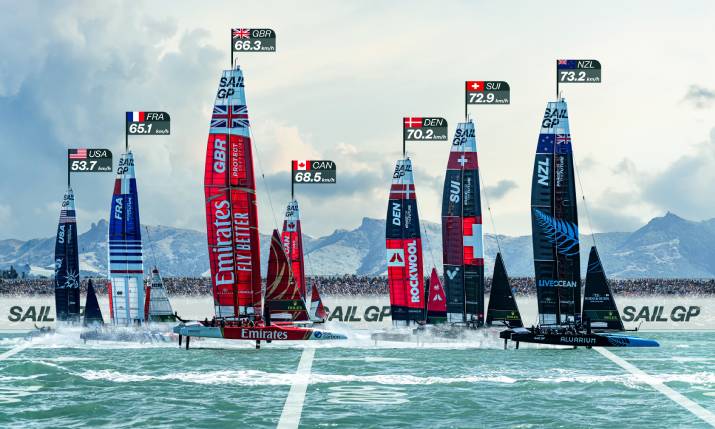RF cameras capture all the activity in the pit lane
The 2023 FIM Superbike season is well underway with eight of the eleven rounds of the World Championship contested before the summer break started last month. Races will resume in September in France, before the season finale in Spain on 27 to 29 October.
Once again, EMG Italy is handling the entire television production of all the competitions. Moreno Roncon, EMG Italy production manager, says: “The season and the whole championship have been organised with a production structure which, on the one hand, is substantially the same as the last edition, but on the other hand, sees significant technological changes. This is because Dorna, the rightsholder, had asked upon renewal of the contract, to produce feeds with a progressive 4K UHD television signal.”
Up until the last edition, filming was done in HD 1080i with mixed optics for a total of 21 cameras, three of which were RF and located in the pit lane.
The configuration of the cameras has remained the same for this season, with one of the three pit lane cameras installed on a DJI Ronin support and three cameras placed on board on the bikes.
Similarly, the mobile vehicle used for the production – the Nova 126 – is the same, but it has undergone heavy modifications and has been completely updated to house the new technologies necessary to create and manage a progressive 4K and 1080p television signal.
“The changes required a large investment which included a new video mixer, five new EVS, each with 12 channels, and new signal management. All 21 cameras are now Sony 4300s with new long lenses (95 and 111),” adds Roncon.
“Two super slow motion cameras were employed for the 6X and 8X replays and the choice of which to use varies from race to race (they are all licensed).”
The setup in motion
At each stage, the production is busy for three days of broadcasting starting with practice day on Friday, and continuing on the race days of Saturday and Sunday. These are broadcast on Sky, Eurosport and on Dorna’s streaming platforms.
The two days of live broadcasts start at nine in the morning and continue until late afternoon, covering all races, including the Super Sport, the 300, the Superbike and the Yamaha Cup.
For all three days EMG Italy creates two different host feeds, one ‘clean’ and one ‘graphic’.
Super slow mos are used for the replays
All production is normally done in HD, but this season tests were carried out – with great success – across the entire production chain with signals entirely produced and processed in UHD.
The signals are created on-site on the circuits and then sent on two feeds, one main via satellite and one backup via optical fibre, to Dorna’s headquarters in Barcelona, and then distributed internationally to the various takers from there.
For the connection of the cameras on the track, EMG Italy creates a set-up where the signals generated in SMPTE standard arrive at hubs strategically located and converted, to then travel via dark fibre and arrive at the main control vehicle.
“Some circuits are pre-wired,” underlines Roncon, “and therefore we can already have many useful points connected in fibre on the track. Hopefully the other circuits will also follow this trend.
“This facilitates the natural evolution which involves the use of electronic flags and remote cameras, useful for the judges of the race direction.”
The technical team
Both the judges and the race director can see the signals from all cameras to make the right decisions, even in deferred mode, thanks to a repository of recorded material that EMG Italy makes available.
In addition to the wiring of the cameras on the track, the production also carries out all the wiring and setting up of the three commentary stations.
The technical team is made up of 18 people who arrive on site on Monday, start with the cabling and assembly of the cameras the following day, and set up the timing, race direction and commentary stations.
The technical alignment tests with Dorna, which is also responsible for the layout of the cameras, begin on Thursday morning.
Three cameras are connected by radio frequency with the direction and take care of all the interviews in front of the closed park that collects the bikes after the finish. They also capture the celebrations and resume the hot interventions of the first three arrivals.
Before this they are busy recording all the activity in the pits, such as the opinions of the team managers in the pit lane, and they take care of resuming the starting grid.
There are three onboard cameras: a front one oriented towards the rider, a rear one to film the pursuers and a front one that shoots the track from the rider’s perspective.
From the mobile vehicle, the director can switch in real time between the three on-board cameras which are connected to a Vislink radio frequency bridge and relative antenna, to transfer the selected RF signal.
Roncon adds: “The technical staff is provided by Dorna. This includes 20 camera operators, plus three RF camera operators, six EVS operators, two co-ordinators in the journalist area, two graphic designers on board and a camera manager.
“We at EMG Italy supply as many as 18 people, including two technicians for the camera connection fibre hubs, a chief technician, two camera controls, an audio mixer and two assistant sound engineers, two for filming the on-board cameras, and three stagehands.
“During the set-up and preparation of the circuit, we also install the receiving equipment for the radio frequency signals. Therefore, in total, for each race we take care of four set-ups: the circuit cameras, the race direction, the timing with the commentary and all the on board.”
Davide Furlan, outdoor production director, says: “The SBK is the most historic production in the EMG Italy portfolio: to give you an idea it was already in our portfolio back in 2008, entering that of EMG after the acquisition of the company in 2019.
“Some internal technicians can count over 160 Grands Prix made during this period, giving us an invaluable level of know-how that has become a real mark of safety and reliability for our customers.
“In all these years there has always been a constant search for technical and narrative innovation. With Dorna we have tried to make production ever richer, while at the same time trying to make processes more simplified and reliable, by investing in technology.”
He continues: “Our customer’s need is always to try to optimise and make the most of the resources in the field. For this reason, we are in constant and close contact with the producer Gonzalo Calvar.
“Each Grand Prix becomes a laboratory to test, innovate and change something and thus make the SBK product ever closer to its DNA, a motorcycle world championship where love and a passion for motorbikes and speed must find all the space they deserve. It is not for nothing that in the motorcycle world SBK is considered the most followed competition by those who ride motorcycles.
“I would like to thank all the people at EMG and the freelancers who have enriched this production over the years with their work and professionalism and have been fundamental to the excellent result we have achieved.”


